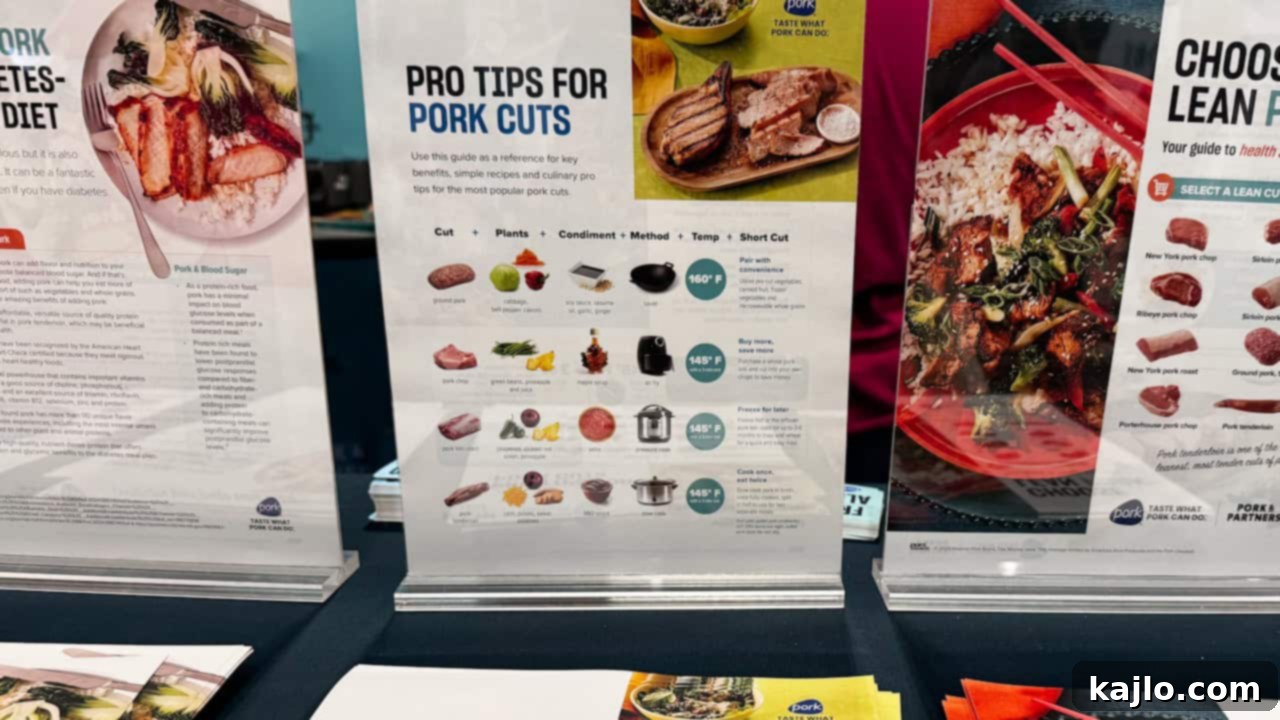Navigating the vast landscape of nutrition can be challenging, especially when aiming for optimal health and effective blood sugar management. Each year, the Food & Nutrition Conference & Expo (FNCE) stands as a premier event, bringing together registered dietitians and nutrition experts to explore the latest advancements, research, and innovative food products. This year, two pivotal trends consistently emerged at the forefront: high-protein and high-fiber foods. These nutritional powerhouses are not merely dietary fads; they represent fundamental pillars for supporting healthier eating patterns, particularly beneficial for individuals managing diabetes.
As a registered dietitian, I’m particularly enthusiastic about the spotlight on protein and fiber, recognizing their profound impact on satiety, blood glucose control, and overall metabolic health. The conference offered a fascinating glimpse into a variety of foods that can significantly contribute to these goals. Below, I’ve curated some of my favorite FNCE food discoveries, focusing on options that can help keep blood sugar levels steady and provide sustained energy throughout the day. This information is intended for general educational purposes only and does not constitute personalized medical or nutritional advice. Always consult with your physician or a registered dietitian who is familiar with your unique medical history and health needs for tailored guidance.
– Summer Yule, MS, RDN
No Added Sugar Greek Yogurt: A Creamy Ally for Blood Sugar

Greek yogurt has long been celebrated for its nutritional benefits, and its role in diabetes management continues to gain scientific backing. The FDA has even issued a qualified health claim, linking regular yogurt consumption to a reduced risk of type 2 diabetes. Specifically, the agency notes, “Eating yogurt regularly, at least 2 cups (3 servings) per week, may reduce the risk of type 2 diabetes according to limited scientific evidence.” This endorsement highlights the potential preventative benefits of incorporating yogurt into your regular diet.
When selecting yogurt, choosing varieties with no added sugar is paramount for those focusing on blood sugar control. Many brands now offer excellent options that are naturally rich in protein, which is key for satiety and preventing rapid blood glucose spikes. High-protein foods help slow down digestion, leading to a more gradual release of glucose into the bloodstream, thus promoting stable blood sugar levels.
Brands like Too Good & Co exemplify this trend, offering a wide array of no-added-sugar Greek yogurt varieties. These products are not only delicious but also packed with protein, helping you feel fuller for longer. Flavors such as Madagascar vanilla, peach, and blueberry make it easy to incorporate into various meals. Enjoy it as a quick and nutritious breakfast, a satisfying afternoon snack, or as a versatile ingredient in recipes. For an innovative take, consider using it to create a fluffy Cloud Bread with Greek Yogurt, offering a keto-friendly alternative to traditional bread.
Lean Pork: A Versatile Protein for Healthy Eating

Pork, a globally cherished protein source, offers an impressive nutritional profile that can be seamlessly integrated into diabetes-friendly meal plans. Its rich flavor and versatility make it a staple in countless cuisines worldwide. For individuals managing blood sugar, pork provides a substantial amount of protein, which is critical for promoting satiety and minimizing post-meal glucose fluctuations. Protein helps to slow the absorption of carbohydrates, contributing to more stable blood sugar levels.
When incorporating pork into a health-conscious diet, especially for heart health and calorie awareness, opting for lean cuts is highly recommended. Lean pork tenderloin, for instance, is an excellent choice, offering a low-fat, high-protein option that aligns perfectly with both carbohydrate exchange and low-carb meal strategies. These cuts deliver essential amino acids and micronutrients without excessive saturated fat.
Beyond its nutritional advantages, lean pork is incredibly adaptable in the kitchen. It can be grilled, roasted, stir-fried, or slow-cooked, providing endless culinary possibilities. For a delicious and efficient meal, try my Instant Pot Stir Fry. While the recipe originally suggests chicken, lean pork strips can be easily substituted, creating a flavorful and satisfying dish that fits perfectly into a balanced, blood-sugar-conscious diet. This provides an excellent way to enjoy protein alongside a medley of non-starchy vegetables.
Soy Foods: Plant-Based Power for Diabetes Management

For those following a vegetarian diet, seeking to reduce meat consumption, or simply looking to diversify their protein sources, soy foods present an outstanding plant-based option. Tofu, tempeh, and edamame are not only packed with high-quality protein but also offer a unique array of phytonutrients, including isoflavones, which have been studied for their potential health benefits. These foods provide a complete protein profile, making them invaluable for maintaining muscle mass and promoting satiety.
When integrating soy foods into a meal plan focused on carbohydrate management, it’s crucial to be mindful of product labels. While many soy products are naturally low in carbohydrates, certain tempeh varieties may include grains alongside soy, which can elevate their carbohydrate content. Always check the nutrition facts to ensure they align with your dietary goals. Edamame, in its whole form, also provides beneficial fiber, further aiding in blood sugar regulation and digestive health.
The versatility of soy foods allows for countless culinary applications. Tofu can be pressed and marinated for stir-fries, baked dishes, or scrambled as a breakfast alternative. Tempeh, with its firmer texture and nutty flavor, absorbs marinades beautifully and makes an excellent meat substitute. For a hearty and carb-conscious meal, try my Tempeh Bolognese Sauce. This flavorful sauce can be served over spaghetti squash or zucchini noodles for a delicious and lower-carb twist on a classic comfort dish, providing both satisfaction and excellent nutrition.
Tinned Seafood: Convenient and Nutrient-Dense Options

Tinned seafood often gets overlooked, but it represents one of the most affordable, convenient, and nutrient-dense ways to incorporate the vast benefits of seafood into your diet. These shelf-stable options provide high-quality protein and a wealth of micronutrients, making them an excellent choice for quick meals and snacks, especially for those prioritizing blood sugar management. The sheer variety available, from classic tuna to more adventurous options, ensures there’s something for every palate.
While tuna remains a popular and accessible choice, exploring other tinned seafood like salmon and sardines offers an added nutritional bonus: they are exceptionally rich in omega-3 fatty acids, specifically DHA and EPA. These essential fats are renowned for their powerful anti-inflammatory properties and their significant role in supporting cardiovascular health and brain function. For individuals with diabetes, maintaining heart health is particularly important, and omega-3s contribute to this vital aspect of well-being.
Tinned seafood is incredibly versatile and can be transformed into a quick, carb-conscious meal in minutes. It pairs wonderfully with fresh vegetables, whole-grain crackers (if carb allowance permits), or as a topping for salads. For a delicious, simple, and satisfying lunch that keeps carbohydrates low, try my Sardine Salad Wraps. Made with crisp lettuce leaves or nutrient-rich collard greens as the wrapper, this recipe is packed with flavor and beneficial nutrients, providing an ideal solution for a busy yet healthy lifestyle.
Eggs: The Ultimate Affordable and Versatile Protein

Eggs are a true nutritional marvel, often hailed as nature’s perfect food. They are an outstanding source of complete protein, meaning they contain all nine essential amino acids necessary for human health. Beyond protein, eggs are remarkably affordable, naturally low in carbohydrates, and versatile enough to fit into almost any meal plan, including vegetarian-friendly approaches. What’s not to love about such a nutrient-dense and accessible food?
The nutritional profile of eggs extends beyond just protein. They are packed with essential vitamins and minerals, including vitamin D, vitamin B12, choline (crucial for brain health), and selenium. The protein content helps to promote satiety, manage appetite, and stabilize blood glucose levels, making them an ideal choice for breakfast, lunch, dinner, or a snack for individuals managing diabetes. The minimal processing involved in eggs further underscores their wholesome appeal.
At the recent Expo, brands like Eggland’s Best Eggs showcased the enduring appeal and nutritional superiority of this simple yet powerful food. Their presence reinforced the message that eggs remain a top choice for a nutritious and satisfying diet. Their versatility allows them to shine in both sweet and savory dishes, from omelets and frittatas to baked goods. For busy mornings when you still crave something wholesome and delicious, one of my favorite quick breakfast recipes is Fried Eggs in the Air Fryer. This method yields perfectly cooked eggs with minimal effort, ensuring a nutritious start to your day.
Low-Carb Fruits and Vegetables: Essential Fiber and Phytonutrients

In discussions about minimally processed foods, fruits and vegetables invariably take center stage, and for good reason. They are fundamental to any healthy eating pattern, especially for those focused on diabetes management. These vibrant foods provide an abundance of dietary fiber, essential vitamins, minerals, and phytonutrients—beneficial plant compounds that support overall health. Furthermore, their high water content contributes significant low-calorie fluid volume, helping you feel full and adequately nourished without impacting blood sugar significantly.
Among the vast array of produce, non-starchy vegetables (like leafy greens, broccoli, cauliflower, bell peppers) and berries (such as strawberries, blueberries, raspberries) are particularly beneficial for individuals following a low-carb approach to diabetes management. These foods offer excellent nutritional value with fewer carbohydrates compared to their starchy counterparts. If you are using carbohydrate exchanges, these options allow for larger, more satisfying portion sizes per exchange, making it easier to meet your fiber and nutrient needs.
Beyond fresh produce, naturally fermented vegetables like sauerkraut and kimchi offer a unique twist. They are a tasty way to add flavor and beneficial probiotics to your diet, supporting gut health. However, it’s worth noting their typically high sodium content, which makes them less suitable for low-sodium diets. For those interested in home fermentation, my Fermented Red Cabbage Sauerkraut Recipe is a fantastic starting point. Its vibrant pink hue adds both visual appeal and a nutritional boost to any meal, inviting you to explore the world of fermented foods.
Almonds: Heart-Healthy Fats and Sustained Energy

Almonds, along with other tree nuts, are widely recognized for being excellent sources of healthy plant-based fats. These monounsaturated and polyunsaturated fats are crucial for heart health and play a significant role in managing cholesterol levels. However, their benefits extend beyond fats; almonds also contribute a valuable amount of protein and dietary fiber to your diet. This combination of healthy fats, protein, and fiber makes them an incredibly satisfying and nutrient-dense snack.
For individuals managing diabetes, the synergistic effect of protein, fiber, and healthy fats in almonds is particularly advantageous. This powerful trio helps to slow digestion, promote a feeling of fullness, and prevent rapid spikes in blood sugar, providing sustained energy throughout the day. A handful of almonds can effectively curb hunger between meals, helping to prevent overeating and supporting weight management goals, which are often integral to diabetes care.
Almonds are wonderfully versatile. They can be enjoyed raw, roasted, or as almond butter. They make a perfect on-the-go snack, a crunchy addition to salads, or a nutritious component in baked goods. For a convenient and customizable snack that keeps carbohydrates low, consider my Low Carb Trail Mix recipe. While it features a delicious blend of pecans, macadamias, and cashews, feel free to personalize it by swapping in almonds or any other favorite nuts for a delightful and energy-boosting treat.
Peanuts: A Legume Packed with Nutrients

Despite commonly being grouped with tree nuts, peanuts are actually legumes, distinguished by their unique growth underground. Nevertheless, like tree nuts, they share an impressive nutritional profile that makes them a smart and delicious addition to balanced meals, particularly for those managing blood sugar. Peanuts are an excellent low-carb source of healthy monounsaturated and polyunsaturated fats, which are beneficial for cardiovascular health. They also provide a significant amount of plant-based protein and dietary fiber.
The combination of healthy fats, protein, and fiber in peanuts contributes to feelings of satiety, helping to manage appetite and reduce the likelihood of overeating. This nutrient synergy also plays a vital role in blood sugar regulation by slowing down the digestion and absorption of carbohydrates, preventing sharp glucose spikes. Peanuts are packed with essential vitamins and minerals, including magnesium, phosphorus, and B vitamins, further enhancing their health benefits.
Peanuts can be enjoyed in various forms: whole, roasted, or as a rich, creamy peanut butter. When choosing peanut butter, opt for natural varieties with minimal added sugar and oils to maximize their health benefits. One of my favorite ways to incorporate the delicious flavor of peanuts into a meal is through this easy Keto Peanut Sauce. It’s incredibly versatile and delicious when served over lean protein (like chicken or tofu) alongside a colorful mix of non-starchy vegetables. This combination creates a quick, satisfying, and flavorful low-carb stir-fry that is perfect for any day of the week.
Sunflower Seeds: An Allergen-Friendly Alternative

For individuals with allergies to tree nuts or peanuts, or simply those looking to diversify their dietary choices, sunflower seeds offer an excellent and highly versatile alternative. These small but mighty seeds are a nutritional powerhouse, providing a beneficial blend of healthy fats, dietary fiber, and plant-based protein. They are an accessible and often more budget-friendly option, making them a smart choice for everyday meals and snacks.
Sunflower seeds are rich in monounsaturated and polyunsaturated fats, including omega-6 fatty acids, and are a good source of vitamin E, an important antioxidant. Their fiber content supports digestive health and, critically for diabetes management, helps to slow down carbohydrate absorption, contributing to more stable blood sugar levels. The protein in sunflower seeds also aids in satiety, helping you feel fuller and more satisfied between meals.
These seeds can often be swapped 1:1 for nuts in many recipes, making them a seamless inclusion in various dishes. They’re excellent for snacking on their own, added to salads for a crunchy texture, sprinkled over yogurt, or incorporated into baking. While delicious as a standalone snack, I particularly enjoy using them in my Leftover Greens Pesto. This pesto is a fantastic way to utilize greens and offers a nutty, flavorful addition to meals. It’s delicious drizzled over roasted vegetables, lean protein, or low-carb pasta, and it also makes a wonderful base for homemade salad dressings, elevating any dish with its unique taste and nutritional benefits.
Sparkling Water: A Refreshing Path to Hydration

Adequate hydration is a cornerstone of overall health, irrespective of whether you are managing diabetes or not. Water plays a crucial role in countless bodily functions, including regulating body temperature, transporting nutrients, and maintaining organ health. For individuals with diabetes, proper hydration can also assist in blood sugar regulation and help prevent complications. However, for many, the taste of plain water can sometimes become monotonous, leading to insufficient intake.
To keep hydration interesting and enjoyable, there are several simple and healthy strategies. One popular method is to create your own infused water by adding slices of fresh fruits (like lemon, lime, or berries) and herbs (such as mint or basil). This provides natural flavor without added sugars or artificial ingredients. Another excellent option is to embrace sparkling water brands like LaCroix, which have gained immense popularity for their refreshing bubbles and diverse flavor profiles.
When choosing sparkling water, it is essential to opt for unsweetened varieties with natural flavoring only. These selections provide zero calories, zero carbohydrates, and no artificial sweeteners, making them a perfect, guilt-free alternative to sugary sodas or juices. Incorporating sparkling water into your daily routine offers a refreshing twist that encourages consistent hydration, supporting your health goals without compromising blood sugar stability. It’s a simple yet effective way to add variety and enjoyment to your fluid intake.
Non-Nutritive Sweeteners: Navigating Sweetness Responsibly

Non-nutritive sweeteners (NNS), also known as artificial sweeteners or sugar substitutes, were a prominent topic and presence at the FNCE Expo. Brands like Truvia (stevia-based) and Lakanto (monk fruit-based) showcased their products, highlighting their appeal for those seeking to reduce sugar and calorie intake without sacrificing sweetness. These sweeteners provide taste without contributing significant calories or carbohydrates, making them attractive for individuals managing diabetes or following low-carb diets.
The role of NNS in a healthy diet is a subject of ongoing discussion among health professionals and consumers alike. Some individuals find these products incredibly helpful for satisfying a sweet tooth in a carb-conscious way, allowing them to enjoy treats without impacting blood sugar levels. They can be particularly useful in recipes, beverages, and packaged foods designed for sugar reduction. For these individuals, NNS can be a valuable tool for adherence to dietary guidelines.
However, others report that consuming NNS can sometimes increase their cravings for sweets or even impact gut microbiota, though research in this area is still evolving. It’s a highly individualized experience, and what works well for one person may not for another. For those who find non-nutritive sweeteners helpful in their journey to manage blood sugar and reduce added sugars, my Diet Lemonade Recipe offers a simple and refreshing option. You can easily use any 1:1 sugar substitute that you prefer and that works best for your personal health goals, allowing for a delightful, sugar-free beverage.
The FNCE conference consistently reinforces that managing diabetes effectively involves a holistic approach, where informed food choices play a critical role. The emphasis on high-protein and high-fiber foods, showcased through these diverse and delicious options, provides a clear roadmap for creating satisfying and blood-sugar-friendly meal plans. From protein-packed Greek yogurt and lean meats to nutrient-rich soy, convenient tinned seafood, versatile eggs, and an abundance of low-carb fruits, vegetables, nuts, and seeds, there are countless ways to nourish your body and stabilize your blood sugar.
Staying hydrated with sparkling water and mindfully using non-nutritive sweeteners also contributes to a well-rounded strategy. Remember, the journey to optimal health is unique to each individual. While these food finds offer excellent starting points, always prioritize consulting with a qualified healthcare professional, such as a physician or registered dietitian. They can provide personalized advice that considers your specific health profile, preferences, and dietary needs, ensuring you receive the most effective and safe guidance for your diabetes management.
Embrace these insights, experiment with new flavors, and empower yourself with knowledge to cultivate a healthier, more balanced lifestyle.
